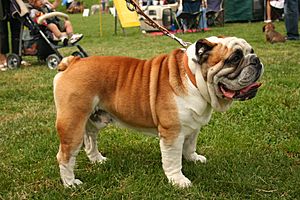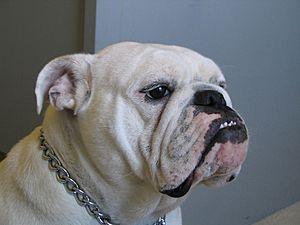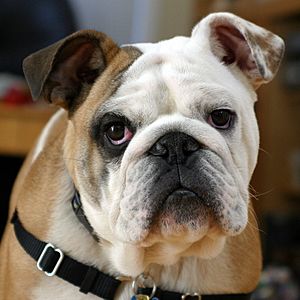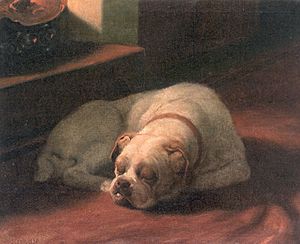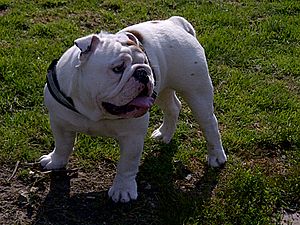Bulldog facts for kids
The Bulldog, also known as the British Bulldog or English Bulldog, is a medium-sized dog breed. It first came from England. Bulldogs are known for their unique look and calm nature.
Contents
What Bulldogs Look Like
Bulldogs have a very distinct look. They have a wide head and shoulders. Their lower jaw sticks out more than their upper jaw, which is called a pronounced underbite. You'll often see thick folds of skin on their forehead, which some people call a "rope" or "nose roll" above their nose. They have round, black eyes that are set wide apart. Their neck has loose skin, and their lips droop down.
Their fur is short, flat, and smooth. Bulldogs can be many colors like red, fawn (a light yellowish-brown), white, brindle (a striped pattern), and piebald (patches of color and white).
Male Bulldogs in the United Kingdom usually weigh about 55 pounds (25 kg). Females weigh around 50 pounds (23 kg). In the United States, males typically weigh about 50 pounds (23 kg), and females weigh about 40 pounds (18 kg). The Bulldog Club of America suggests a weight between 40 to 50 pounds (18 to 23 kg).
One interesting fact about Bulldogs is that their tails are naturally short. They can be straight or look like a screw. This means their tails are not cut or docked like some other dog breeds.
How Bulldogs Act
Bulldogs are known for being very kind and calm dogs. They are also brave and determined. They are not usually mean or aggressive. The American Kennel Club (AKC) describes their personality as "equable and kind, resolute, and courageous." This means they are steady, friendly, and brave.
Dog breeders have worked hard to make sure Bulldogs are not aggressive. Most Bulldogs are friendly, patient, and a bit stubborn. They are often seen as great family pets because they tend to form strong bonds with children.
Generally, Bulldogs get along well with kids, other dogs, and other pets.
History of Bulldogs
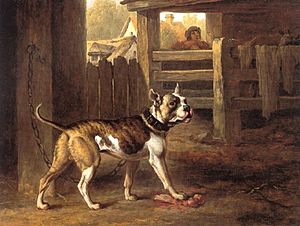
The word "Bulldog" was first used in writing around the year 1500. The name "bull" came from a sport called bull baiting. In this sport, dogs were set loose on a bull that was tied up. The dog that could grab the bull by the nose and hold it down would win.
Bull baiting was very popular in England until the early 1800s. It became illegal in 1835 with the Cruelty to Animals Act 1835. This law protected animals from being mistreated. After this, the Old English Bulldog, which was used for bull baiting, was no longer needed for that purpose in England.
However, some people who moved to the New World (America) still found uses for these dogs. For example, in the mid-1600s in New York, Bulldogs helped city leaders catch wild bulls. They were trained to hold a bull by its nose so a rope could be put around its neck.
Even though today's Bulldog looks strong, it cannot do the same jobs its ancestors did. They cannot handle the tough physical challenges of fighting a bull. Modern Bulldogs are much calmer and less aggressive than their ancestors. They are still good guard dogs and loyal companions.
The oldest club for this specific breed is The Bulldog Club in England, started in 1878. This club helped create the first standards for what a perfect Bulldog should look like. In 1894, two famous Bulldogs, King Orry and Dockleaf, had a walking contest. King Orry was lighter and more athletic, like the older Bulldogs. Dockleaf was smaller and heavier, more like modern Bulldogs. King Orry won the 20-mile walk, while Dockleaf got tired. The American Kennel Club officially recognized the Bulldog breed in 1886.
Bulldog Health
Like all dogs, Bulldogs need daily exercise. If they don't get enough exercise, they can become overweight. This can lead to heart and lung problems, and put stress on their joints.
Bulldogs have very small nasal passages, which means they can have trouble cooling down. They are very sensitive to heat. It's important to be extra careful with them in warm weather or during summer. Bulldogs need plenty of shade and water. They must be kept out of hot places. Air conditioning and good airflow are important to keep them healthy and safe. Bulldogs sweat mostly through the pads on their feet, so they often like cool floors. Because they are a brachycephalic breed (meaning "short-faced"), Bulldogs can easily get too hot and even die from hyperthermia (overheating).
Bulldog owners can help their dogs stay healthy by being aware of these issues and protecting them from unsafe conditions.
Bulldogs can breathe loudly and often snore a lot.
Some Bulldogs can get a condition called "cherry eye." This happens when a tear gland in their eye swells up and turns red, covering part of the eye. This usually happens in dogs under two years old and needs surgery to fix it.
Related Pages
See also
 In Spanish: Bulldog para niños
In Spanish: Bulldog para niños


